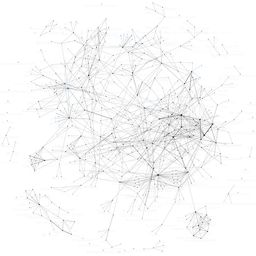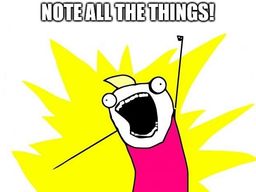Zettelkasten - what I learned about the journey of note-taking
📋 Summary
I must confess that I have no memory.
🧠 A memory lapse #
I have tried many methods and tools to overcome this failure : notebook, post-it, Google Keep, text files… I have to admit that none had worked for me. I didn’t know how to gather all my notes in one place. And above all, I was unable to capitalize on these notes. A real bazaar.
However, I discovered the Zettelkasten method a year ago[1]. And I think I found the system I was missing to take notes, organize them, improve them and capitalize on them. Since then, I have two brains, I have increased my productivity, and I don’t forget anything.
This is what my notes network looks like after a year with nearly 400 notes and over 130k words):

Today, I’d like to share with you what I’ve learned on my note-taking journey.
👨🏫 Learnings about note-taking #
Write down to memorize #
Writing enhances certain parts of your brain and boosts your learning abilities which is why I keep a small note with me pretty much all the time to jot down important pieces of information.
And it works very well for me. I remember better what I wrote. And anyway, I have a backup plan with my notes. I can come back to them later whenever I need.
Note all the things #
It’s not only to remember. These notes will come in handy one day. Copying/pasting a note is very rewarding.
Plus, sometimes I need to go back to basics. So even the simplest note is valuable.
So write down all your thoughts: to-do list, your goals, minutes of meeting, comments on podcasts and shows…
Write them down at all times, lest you forget them. When taking notes, try to stick to the essentials to be effective.

Honestly, learning without taking note has become a black hole for me.
Write every day #
I write every day to get used to writing. It’s not easy but doable with perseverance. In this way, I become more comfortable and get better at it day to day.
But also so as not to forget what I learned on D-Day. I write it down when it’s still fresh in my head.
Link concepts and ideas #
I have many interests. Some may overlap. The connections between each topic are key to navigating my mind. Moreover, some complex concepts have interdependencies with many notions.
To achieve that, I primarily use internal links (aka wikilink) between notes. On the same way, I use and abuse of tags. I’ve always been a big fan of tags. It’s a very simple tool to organize objects without creating a hierarchy.
When I feel a tag becomes an important notion. That it should be developed. So I replace it with a placeholder[2].
Divide and rule #
Whenever I have the opportunity, I divide my notes into smaller ones. This way I can reuse them anytime. Also, it will be easier to navigate and get to the core concept.
For example, I started a note on the JVM. Step by step, I completed it. Then at some point, I had to extract everything related to the garbage collector in a dedicated note, as well as the performance aspects, the different implementations in another one, etc…
Now I have a central note on the JVM with specialized branches (garbage collector, implementations, performances…) that I can link directly into other notes.
Reorganize each time you can #
I refine my notes as I learn, like the Feynman learning technique.
My understanding of the concepts improves as the notes change.
So, I need to move or restructure them because I have a better understanding.
Template your notes #
Quickly, standard notes appeared: project idea, study of architecture concepts, curation of topic, web review, tutorial…
I created a template for each one. So all notes have the same structure, I save time and I have a checklist on the aspects to dig into.
Copy/paste your notes for sharing #
I have already mentioned it. Sharing my notes allows me to explain understandings or thoughts at the speed of light.
I need to explain a concept? I copy/paste my note on the subject to share the content. Do I have to list the advantages or disadvantages of such an approach? I copy/paste my note on this approach to share my concerns.
Easy and blasting fast!
Write articles #
Before, I used a CMS to prepare my articles. They were isolated from my notes with no link to them. Moreover, these articles could be forgotten in this side tool.
Now they are part of my thought pattern. Every day is an opportunity to complete a long-term article in small steps. And when the article is ready, I can publish it as it is.
🧰 Note-taking toolbox #
I know many of you are now wondering which tools I use to take notes. I don’t think there is a perfect tool. But rather, there are tools that are suitable for everyone. Even so, here in a nutshell is my environment for taking notes.
There are many ways to take notes[3]. Since I decided to follow more or less the slip box method, I used Zettelkasten oriented tools. Likewise, since I use development tools, it seemed obvious to me to adopt a code approach. That’s why I use:
- Markdown as note format
- VSCodium with the Foam extension to write and explore notes
- git to log changes
- github to store all my notes
🦸♂️ Become a note-taking superhero #
Today, these notes are my secondary brain. They allow me to reduce my mental load. I am relieved and no longer forget what I learn and know.
I brain dump once at the end of my working day and a second time before going to bed.
Do you, and how do you manage your notes? What did you learn?
Links point to a note to create. ↩︎
Emmanuel Bernard has explored several. ↩︎